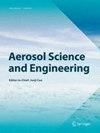A Protocol for Measuring Variations of Aerosol Soluble Proteins Content in Hours at Low Sampling Flow Rate Using the Bicinchoninic Acid (BCA) Assay
Abstract
Proteins in aerosols are the core biological components connecting geographical isolated ecosystems via the atmosphere, and also an increasing concern for their high allergic potential. The prolonged sample collection time of days and even weeks required in current aerosol proteins studies makes it difficult to investigate the variation of proteins concentration with weather and, consequently, to explore the sources of the proteins and their correlations with other aerosol components. Using bicinchoninic acid (BCA) assay and cold acetone precipitation, we developed a protocol to quantify the aerosol soluble proteins (ASPs) in samples collected at a low flow rate in hours. Laboratory experiments with bovine serum albumin solution were conducted to optimize the operational procedures and conditions for a stable and efficient proteins recovery rate (RCP). The results showed that the optimal dosage of cold acetone for the protein precipitations was a 5-fold sample solution in volume. The most effective air-dried conditions for protein precipitations were in an environment with a relative humidity of 20 ± 2% and a temperature below 20 °C for 2 h. The RCP was stable at 42.0 ± 8.0% (proteins concentration in solution: 2–40 µg mL–1). Test applications of the protocol to samples collected for 6 h at 10–16 L min–1 flow rate in the lightly polluted urban air of a coastal city in Japan demonstrated the effectiveness of the protocol in measuring the variation of ASPs in hours. The result revealed that the ASPs concentration in Kumamoto ranged from 0.07 to 1.29 µg m–3 in winter and had a positive correlation with particulate matter.

 求助内容:
求助内容: 应助结果提醒方式:
应助结果提醒方式:


